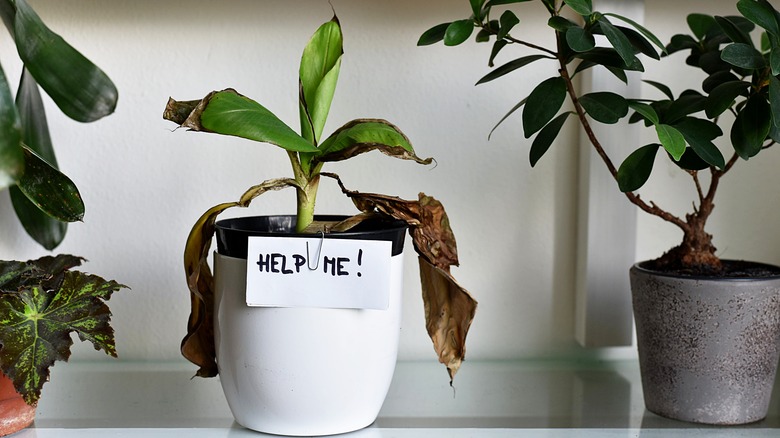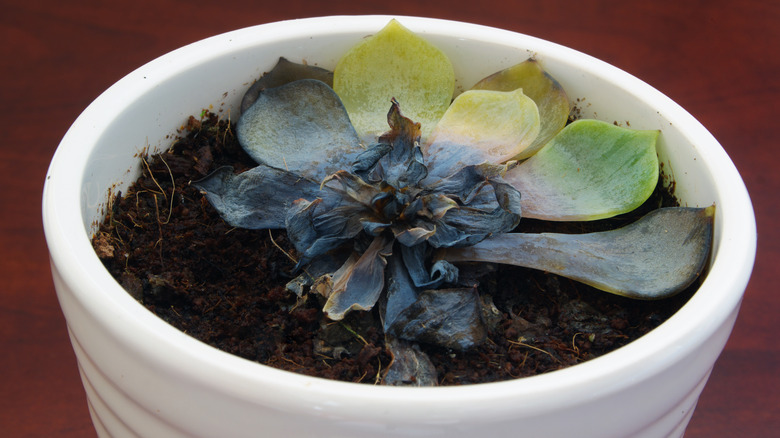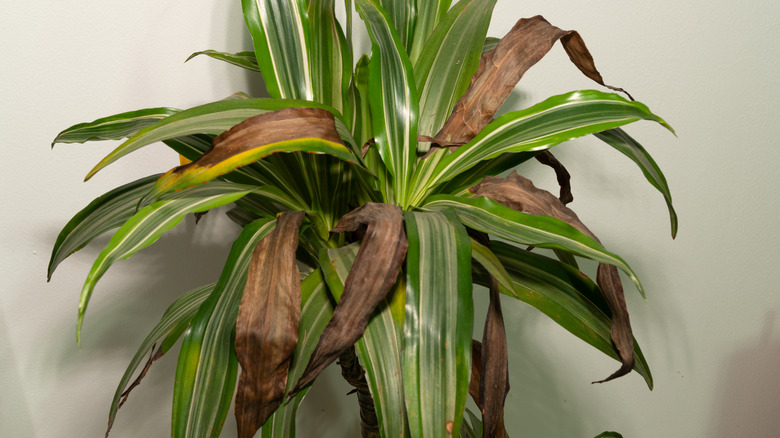What It Means If Leaves On Your Houseplants Are Turning Black
Houseplants can be a joy to take care of, and they make a great addition as decor and natural beauty in any room in your home. When they're healthy and thriving, they can encourage peace and relaxation. Unfortunately, like any living thing, houseplants can become sick or stressed, and ultimately, their leaves may turn black. While the root cause of this problem could be one of many things, environmental factors like overwatering, poor drainage, and environmental stress are a few leading reasons why your houseplant's leaves may be turning black. Overwatering your houseplants saturates the soil, causing root rot due to oxygen deprivation, which can negatively affect nutrient absorption. By developing a consistent watering routine and allowing soil to dry out in between, you can ensure your plants get just the right amount of water to flourish.
Poor drainage also exacerbates the root rot issue by trapping excess water in the pot, creating a favorable environment for root diseases. To address poor drainage, replant the affected houseplant in a container with adequate drainage holes and utilize a well-draining potting mix. This adjustment helps prevent waterlogging and promotes healthier root development.
Finally, environmental stressors such as temperature fluctuations or prolonged exposure to direct sunlight can induce stress in houseplants, resulting in blackened leaves. To mitigate environmental stress, maintain stable indoor temperatures and gradually introduce them to direct sunlight to prevent leaf scorch. Implementing these measures will help provide optimal growing conditions, reducing the likelihood of blackened leaves.
Improper nutrition or fertilization
In addition to environmental issues, nutritional problems and chemical exposure through fertilizers can also lead to the blackening leaves on your houseplants. Nutritional deficiencies, particularly a lack of nitrogen, can cause leaves to turn black as the plant struggles to maintain its health. Additional signs of nutrient deficiencies may include yellowing or browning leaves, stunted growth, or leaf drop. To remedy nutritional deficiencies, consider using a balanced fertilizer specifically formulated for houseplants, following the instructions carefully to avoid over-fertilization, which can also cause leaf damage.
Ironically, the same fertilizer your plants may need can also cause black spots or edges on the leaves if applied too liberally. Symptoms of chemical exposure due to over-fertilizing may include burnt or distorted foliage and stunted growth. To prevent chemical exposure, opt for organic or gentle fertilizers. If chemical exposure occurs accidentally, thoroughly rinse the affected foliage with water to remove any residues, and consider repotting the plant with fresh soil to minimize further exposure.
Regularly monitoring houseplants for signs of nutritional problems or chemical exposure is essential for early detection and intervention. Maintaining proper fertilization practices and using gentle, plant-friendly products can help prevent these issues from affecting your plants. Additionally, providing adequate water and light, as well as ensuring proper ventilation, promotes overall plant health and resilience to stressors. By minimizing chemical exposure and addressing nutritional deficiencies, you'll prevent the blackening of your houseplants' leaves and promote thriving indoor greenery.
Pest problems
Finally, if you've noticed your plants developing blackening leaves, another cause may be biological factors like fungal or bacterial infections. These types of infections often manifest as black spots or patches on the leaves, indicating diseases such as leaf spot or botrytis. Signs of these infections include lesions, wilting, or a fuzzy growth on the leaves. To remedy fungal or bacterial infections, promptly remove affected leaves to prevent further spread, improve air circulation around the plant, and avoid overhead watering to reduce moisture on foliage.
Additionally, pest problems by insects such as aphids, spider mites, or scale insects can also cause blackened leaves as they feed on plant tissues or excrete honeydew, which attracts mold. Signs of pest infestations include distorted leaves, webs, or visible insects on the plant. To address pest infestations, isolate the affected plant to prevent the spread of pests, manually remove insects if feasible, and consider using natural predators or insecticidal soap to control the infestation.
Regularly inspecting your houseplants for signs of fungal or bacterial infections and pest infestations is crucial for early detection and effective management. Maintaining good plant hygiene, such as cleaning pots and pruning dead or damaged foliage, can also help prevent these biological factors from affecting your plants. By promptly addressing fungal or bacterial infections and pest infestations and implementing appropriate remedies, you can protect your houseplants from developing blackened leaves and promote their overall health and vitality, ensuring they're flourishing and adding to the tranquility of your home.


